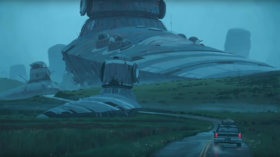Post-apocalypse US: Russian fan turns iconic ‘Electric State’ comic into movie before Hollywood

‘Electric State’ the movie, based on the breathtaking artwork of Swedish illustrator Simon Stalenhag, has at last been confirmed. And one Russian artist has already provided a glimpse of how the post-apocalyptic flick might look.
Gigantic futuristic structures and carcasses of massive battle robots seamlessly embedded into images of rural America – those were the visuals in the Kickstarter-funded art book that propelled Stalenhag to international fame in 2017.
The story of a teenage girl and her yellow toy robot traveling through the desolated US West Coast even captivated Hollywood. The eagerly awaited ‘Electric State’ cinema adaptation was in limbo for some time but, last week, writers Christopher Markus and Stephen McFeely, who have smash hit ‘Avengers: Endgame’ on their resumé, said that the movie is happening.
One of those also impressed by Stalenhag’s style and creativity was his Russian counterpart, Ivan Plotnikov. “When I looked at the first picture I was carried away into another world,” he recalled, saying that the idea of animating the Swede’s art book was merely an attempt to stay in that world for longer.

Bringing the static pictures to life required weeks of hard work as Ivan had to “cut them into front, middle and back layers, so that they could move at different speeds, while creating the feeling of scope and depth. It was from three to ten layers, usually.” There was also a lot of drawing involved as the artist had to fill in the blanks that appeared after he’d moved objects in the images.

Plotnikov initially wanted to use voice actors and several music themes for his animation, but then ruled that “it would contradict the mood of the artworks.” A solemn tune, written by Stalenhag himself, plays over the clip instead.
Also on rt.com Ukraine promises to turn Chernobyl disaster zone from ‘symbol of corruption’ to ‘tourist magnet’Think your friends would be interested? Share this story!














